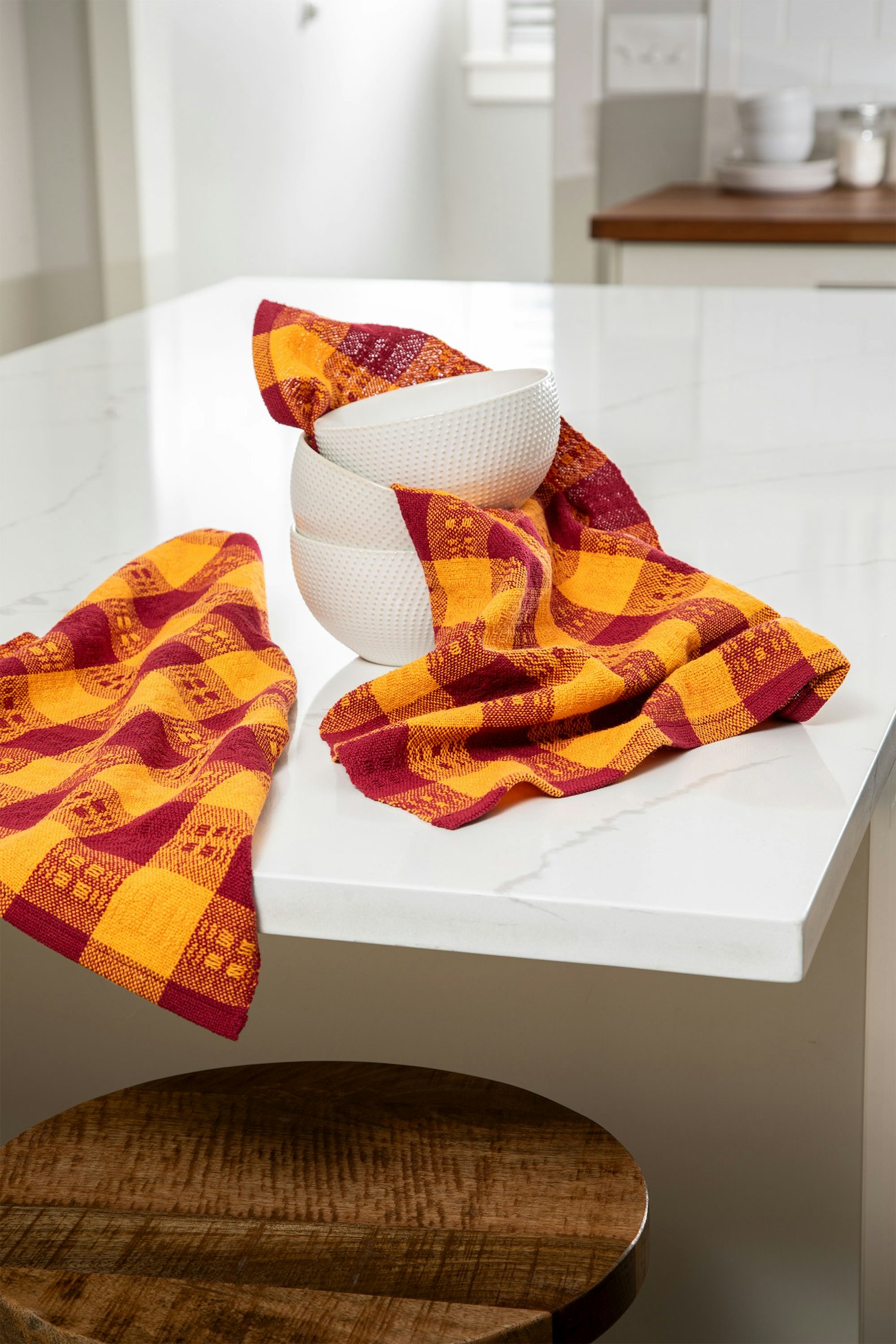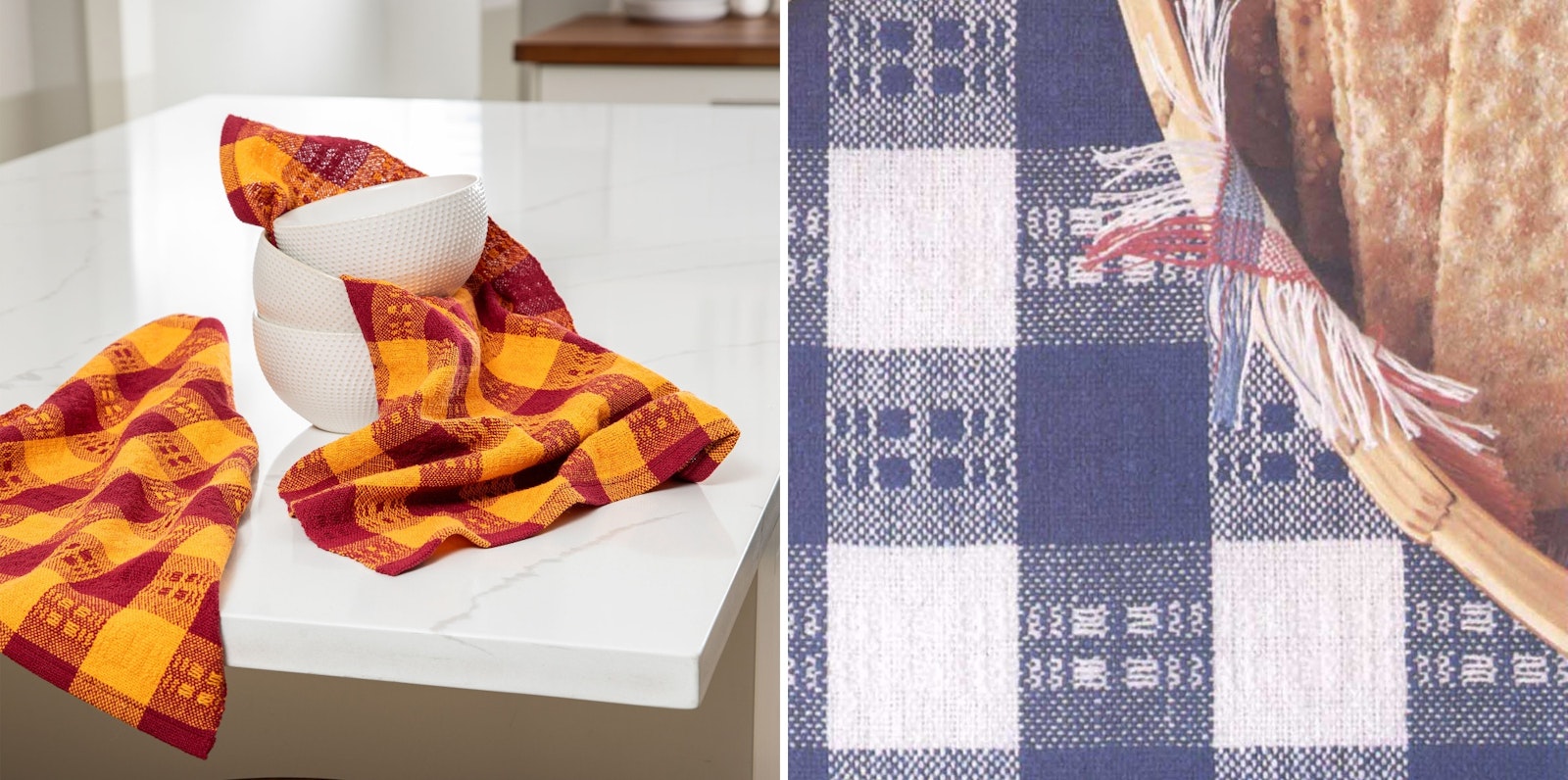Subscriber Exclusive
Reinterpreting Old Weaves for Today and Tomorrow
This article and tablecloth pattern from 1987 inspired Susan A. Bloomfield to design and weave her Monk's Belt Revisited towels.
This article and tablecloth pattern from 1987 inspired Susan A. Bloomfield to design and weave her Monk's Belt Revisited towels. <a href="https://handwovenmagazine.com/reinterpreting-old-weaves-for-today-and-tomorrow/">Continue reading.</a>
https://handwovenmagazine.com/cdn-cgi/image/format=auto/https://www.datocms-assets.com/75077/1708023938-reinterpreting-header.jpg?auto=format&w=900
Not too long ago, Susan A. Bloomfield was perusing old Handwoven issues and came upon this article and tablecloth project from Handwoven May/June 1987. She believes she probably skipped over it as a newer weaver, thinking it was above her abilities. Years later, with more years of weaving experience, it made perfect sense to her. Susan wove her 4-shaft towels in honor of the tablecloth from 1987, which itself was based on a small sample from the 1920s or 1930s.
Start by revisiting this original article from designer Margaretha Essen-Hedin, and then weave up your own monk's belt towels using the two designs included below.
Reinterpreting Old Weaves
From Designer Margaretha Essen-Hedin: As often as I can take a day off from my weaving, I spend the day at Värmlands Museum in Karlstad. The first time I entered the textile department of this museum I felt like a kid in a toy store. I did not know what to play with first. Finally, I settled on 15 file boxes filled with small pieces of handwoven fabric, the result of somebody’s travels around our province in the ’20s and ’30s to save what could be saved of some of our old weavings. These fabric scraps were glued on file cards, which also held information about the fabric and its origin.
We can learn so much from the work in these boxes, and the information fills me with respect for the women of the past who left this impressive heritage. What a great responsibility we have. We need to preserve this heritage and resurface it for the next generation of weavers.
A Special Fabric Piece
One particularly interesting fabric I found in these boxes was a monk’s belt variation (shown below). Unfortunately, there is no information about how this fabric was used, but I guess it was a dress fabric. It was woven at 25 threads per centimeter (about 63 ends per inch [epi]) in a fine cotton thread that is not available today. But if you want to make a similar dress fabric, I suggest you use 24/2 cotton at 18 ends per centimeter (about 45 epi).
I often interpret old patterns in other kinds of fabrics by changing their scale and colors, as I’ve done for the tablecloth fabric shown on the left side of the picture below. The yarn is 22/2 cottolin in blue and white; the sett is about 23 epi.

On the right, historical dress fabric swatch from Värmlands Museum, Karlstad, Sweden, Photo courtesy of Margaretha Essen-Hedin
A Brief History of Table Linens
Little information about table customs before the Middle Ages is available. A few tables with painted tops survive from this time. It is believed that during the 1500s, damask linen table cloths were imported from Holland and Flanders by the wealthy class and used for banquets, which demanded a showy display as well as culinary excellence. The napkin is thought to have gotten its start at these great feasts. A special cloth, stretching the length of the table and resting on the feasters’ laps, was provided for the wiping of fingers.
During the 17th century, ornate table linens were made in Sweden but used only by the wealthy. It wasn’t until the early 1800s that the tablecloth became common in all strata of society. This development corresponded to the wide availability of inexpensive imported cotton. Because cotton thread was readily available, less time needed to be devoted to the time-intensive processing of flax into the linen commonly used for table linens. This freed more time for cloth production, resulting in the use of table linens in everyday life across all strata of society.
Design #1: Heritage Tablecloth by Margaretha
Project Notes: This is my version of the special monk's belt fabric piece I found in the Värmlands Museum collection. The original fabric is a very fine (64 epi) cotton piece, possibly originally a dress fabric, probably woven by Lovisa Andersson over 50 years ago in a village north of Karlstad. I have used heavier threads to weave this country-style tablecloth with respect for the women of the past who have left this heritage to us weavers of today.
SUBSCRIBER EXCLUSIVE
Not too long ago, Susan A. Bloomfield was perusing old Handwoven issues and came upon this article and tablecloth project from Handwoven May/June 1987. She believes she probably skipped over it as a newer weaver, thinking it was above her abilities. Years later, with more years of weaving experience, it made perfect sense to her. Susan wove her 4-shaft towels in honor of the tablecloth from 1987, which itself was based on a small sample from the 1920s or 1930s.
Start by revisiting this original article from designer Margaretha Essen-Hedin, and then weave up your own monk's belt towels using the two designs included below.
Reinterpreting Old Weaves
From Designer Margaretha Essen-Hedin: As often as I can take a day off from my weaving, I spend the day at Värmlands Museum in Karlstad. The first time I entered the textile department of this museum I felt like a kid in a toy store. I did not know what to play with first. Finally, I settled on 15 file boxes filled with small pieces of handwoven fabric, the result of somebody’s travels around our province in the ’20s and ’30s to save what could be saved of some of our old weavings. These fabric scraps were glued on file cards, which also held information about the fabric and its origin.
We can learn so much from the work in these boxes, and the information fills me with respect for the women of the past who left this impressive heritage. What a great responsibility we have. We need to preserve this heritage and resurface it for the next generation of weavers.
A Special Fabric Piece
One particularly interesting fabric I found in these boxes was a monk’s belt variation (shown below). Unfortunately, there is no information about how this fabric was used, but I guess it was a dress fabric. It was woven at 25 threads per centimeter (about 63 ends per inch [epi]) in a fine cotton thread that is not available today. But if you want to make a similar dress fabric, I suggest you use 24/2 cotton at 18 ends per centimeter (about 45 epi).
I often interpret old patterns in other kinds of fabrics by changing their scale and colors, as I’ve done for the tablecloth fabric shown on the left side of the picture below. The yarn is 22/2 cottolin in blue and white; the sett is about 23 epi.

On the right, historical dress fabric swatch from Värmlands Museum, Karlstad, Sweden, Photo courtesy of Margaretha Essen-Hedin
A Brief History of Table Linens
Little information about table customs before the Middle Ages is available. A few tables with painted tops survive from this time. It is believed that during the 1500s, damask linen table cloths were imported from Holland and Flanders by the wealthy class and used for banquets, which demanded a showy display as well as culinary excellence. The napkin is thought to have gotten its start at these great feasts. A special cloth, stretching the length of the table and resting on the feasters’ laps, was provided for the wiping of fingers.
During the 17th century, ornate table linens were made in Sweden but used only by the wealthy. It wasn’t until the early 1800s that the tablecloth became common in all strata of society. This development corresponded to the wide availability of inexpensive imported cotton. Because cotton thread was readily available, less time needed to be devoted to the time-intensive processing of flax into the linen commonly used for table linens. This freed more time for cloth production, resulting in the use of table linens in everyday life across all strata of society.
Design #1: Heritage Tablecloth by Margaretha
Project Notes: This is my version of the special monk's belt fabric piece I found in the Värmlands Museum collection. The original fabric is a very fine (64 epi) cotton piece, possibly originally a dress fabric, probably woven by Lovisa Andersson over 50 years ago in a village north of Karlstad. I have used heavier threads to weave this country-style tablecloth with respect for the women of the past who have left this heritage to us weavers of today.[PAYWALL]
Fabric Description: Monk’s belt and plain weave.
Finished Dimensions: 38" wide by 38" long, including ⅜" hem on each end.
Warp & Weft: 22/2 cottolin at 3,172 yd/lb. This is Borgs’ Bomullin Nm 22/2 from Glimakra Looms 'n Yarns, available as 1,744-yd/250-g tubes: 1,765 yd #0286 medium blue and 1,688 yd #0020 bleached white.
Notions: Matching blue sewing thread.
EPI: 22 ½ (sleyed 1,2 in a 15-dent reed).
Width in Reed: 43 ¼".
Warp Length: 2 yd, which includes take-up, shrinkage, and 27" loom waste.
PPI: 22 ½.
Take-up & Shrinkage: 12% in width and length.
Weaving: Using white weft, weave ¾" plain weave for hem. Weave complete repeat 13 times. Finish with one more blue band. With white, weave ¾" plain weave for the other hem.
Finishing: Machine stitch ends to prevent fraying. Turn each end under ⅜" twice so that no white shows on the front; hand stitch. Machine wash on a short gentle cycle; iron while still damp.
 The draft for Heritage Tablecloth by Margaretha Essen-Hedin
The draft for Heritage Tablecloth by Margaretha Essen-Hedin
Current Handwoven subscribers can also download Susan’s new weaving pattern below.
Design #2: Monk’s Belt Revisited by Susan
Susan A. Bloomfield wove her Monk’s Belt Revisited towels using her own colors and a reduced version of the draft. Click here to get the PDF download of Susan's new Monk’s Belt Revisited pattern.




 The draft for Heritage Tablecloth by Margaretha Essen-Hedin
The draft for Heritage Tablecloth by Margaretha Essen-Hedin 